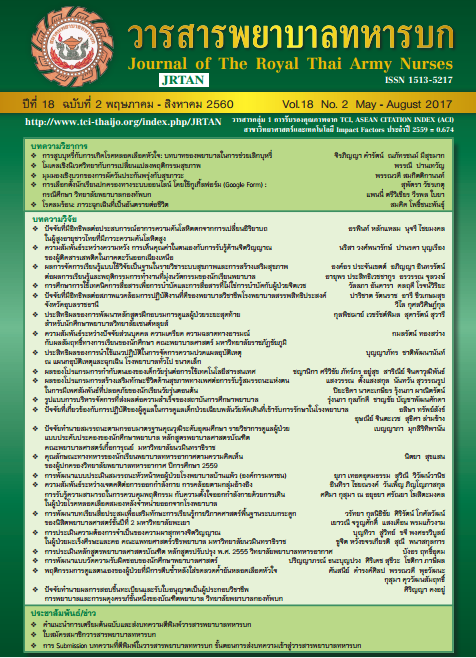ประสิทธิผลของการนำใช้แนวปฏิบัติในการจัดการความปวดแผลอุบัติเหตุ ณ แผนกอุบัติเหตุและฉุกเฉิน โรงพยาบาลทั่วไปขนาดเล็ก
Keywords:
การจัดการความปวด, ปวด, แผลอุบัติเหตุ, แผนกอุบัติเหตุและฉุกเฉิน, เคลฟเวอร์โมเดล, Pain management, Pain, Traumatic wound, Emergency department, CLEVER ModelAbstract
การวิจัยนี้เป็นการวิจัยกึ่งทดลอง มีวัตถุประสงค์เพื่อศึกษาประสิทธิผลการนำใช้แนวปฏิบัติในการจัดการความปวดแผล อุบัติเหตุณ แผนกอุบัติเหตุและฉุกเฉิน โรงพยาบาลทั่วไปขนาดเล็ก ระหว่างเดือนสิงหาคม - ธันวาคม พ.ศ. 2559 กลุ่มตัวอย่างคือ ผู้ป่วยที่มีแผลอุบัติเหตุจำนวน 80 ราย คัดเลือกตามเกณฑ์และสุ่มกลุ่มตัวอย่างแบบง่าย แบ่งเป็นกลุ่มละ 40 ราย กลุ่มควบคุมคือ ผู้ป่วยที่เข้ารับการรักษาก่อนนำใช้แนวปฏิบัติฯและกลุ่มทดลองคือผู้ป่วยที่เข้ารับการรักษาในช่วงสัปดาห์ที่9 หลังนำใช้แนวปฏิบัติฯ เครื่องมือที่ใช้ในการวิจัยได้แก่ แนวปฏิบัติในการจัดการความปวดแผลอุบัติเหตุ แบบประเมินคุณภาพของแนวปฏิบัติทางคลินิก และแบบประเมินประสิทธิผลการนำใช้แนวปฏิบัติฯเครื่องมือทุกชุดผ่านการตรวจสอบความตรงด้านเนื้อหาจากผู้ทรงคุณวุฒิจำนวน 3คน และนำเครื่องมือชุดที่3 หาความเที่ยงโดยสัมประสิทธิ์แอลฟาครอนบาคได้เท่ากับ .80วิเคราะห์ข้อมูลโดยใช้สถิติบรรยายและ สถิติอ้างอิง ผลการศึกษาพบว่า ความพึงพอใจโดยรวมของผู้ป่วยกลุ่มทดลองสูงกว่ากลุ่มควบคุมอย่างมีนัยสำคัญ (p = .000) และ ระยะเวลารอการได้รับยาแก้ปวดของกลุ่มทดลองต่ำกว่ากลุ่มควบคุมอย่างมีนัยสำคัญทางสถิติ(p = .006)แสดงให้เห็นว่าแนวปฏิบัติ ในการจัดการความปวดจากแผลอุบัติเหตุณ งานอุบัติเหตุฉุกเฉิน สามารถนำใช้ในโรงพยาบาลทั่วไปขนาดเล็กได้อย่างมีประสิทธิผล จึงมีข้อเสนอแนะให้มีการนำใช้แนวปฏิบัติฯ ดังกล่าวในโรงพยาบาลระดับอื่น โดยปรับเปลี่ยนข้อเสนอแนะของแนวปฏิบัติฯ ให้มี ความสอดคล้องกับวัฒนธรรมและบริบทของหน่วยงาน
Effectiveness of Implementing the Clinical Practice Guidelines for Traumatic Wound Pain Management at Emergency Department in Middle-level Hospital
The purpose of this quasi-experimental research was to study the effectiveness of implementing the clinical practice guidelines for traumatic wound management at the emergency department in a middle-level hospital during August-December 2016. The sample consisted of 80 traumatic wound patients selected with a simplerandom sampling method and divided into2groups with40subjectseach.Thecontrol group comprised patients being admitted beforetheguidelines’ implementation, whiletheexperimental group’s patients were admitted during the 9th week after the implementation. The instruments included the Traumatic Wound Pain Management Clinical Practice Guidelines (PMCPG-TW), the Appraisal of Guidelines for Research and Evaluation (AGREE), and the questionnairefor assessingeffectivenessof thePMCPG-TW’s implementation.All instruments were verified for content validity by 3 professional experts. Reliabilityof the 3rd instruments as determined by Cronbach’s alpha was at .80. The collected data were analyzed with descriptive and inferential statistics. The study results revealed that the overall satisfaction of patients in the experimental group was significantly higher than the control group (p = .000), and their average waiting time for pain medication was shorter than the control group significantly (p = .006). These results imply that the PMCPG-TW can be implemented effectively foremergency wound management in middle-levelhospital. Hence, implementation of the guidelines is recommended for hospitals at other levels based on some adjustments according to the culture and context of the organization.
Downloads
How to Cite
Issue
Section
License
บทความหรือข้อคิดเห็นใดใดที่ปรากฏในวารสารพยาบาลทหารบกเป็นวรรณกรรมของผู้เขียน ซึ่งบรรณาธิการหรือสมาคมพยาบาลทหารบก ไม่จำเป็นต้องเห็นด้วย
บทความที่ได้รับการตีพิมพ์เป็นลิขสิทธิ์ของวารสารพยาบาลทหารบก
The ideas and opinions expressed in the Journal of The Royal Thai Army Nurses are those of the authors and not necessarily those
of the editor or Royal Thai Army Nurses Association.





